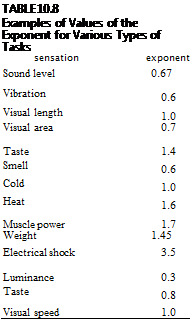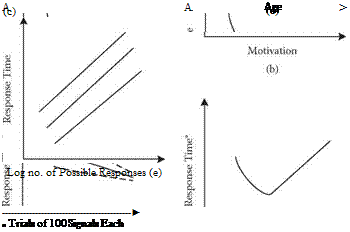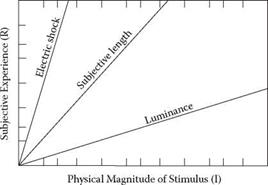The time taken to react to a stimulus by carrying out a certain action is called reaction time (also called response time). This could be, for example, pressing a button when a lamp lights. The greatest part of the reaction time is taken up centrally in the brain, that is, in making the decision to press the button. The time it takes for the signal to get from the eye to the brain and from the central parts of the brain out to the muscles that are to be contracted constitutes only a small part of the total reaction time. Variations in reaction time vary with different sense organs. For hearing and touch, the reaction time is about 140 ms. For vision it is about 180 ms if the person is prepared for the signal. If someone is not prepared, the reaction time increases considerably. Reaction time for smell and taste are about 500 to 1000 ms. For warning signals where a rapid response is important, it is best to use the senses of hearing or touch, or to use these two senses together.
Reaction time (RT) reduces when the amplitude (strength) of the signal increases (see Figure 10.9a). The degree of motivation also affects RT (Figure 10.9b). If it is important for the operator to respond quickly, RT is reduced. Rapid reactions
|
|
Stimulus
 Sound pressure from 3000 Hz tone Amplitude at 250 Hz on finger Drawn line Drawn square Salt
Sound pressure from 3000 Hz tone Amplitude at 250 Hz on finger Drawn line Drawn square Salt
Heptane
Metal contact on arm Metal contact on arm Static contraction Lifting weights Current through finger Point source Saccharine Moving light object
can also be trained. Figure 10.9c shows how the reaction time is reduced for each repeated attempt. Figure 10.9 also shows that the variation between different operators can also be reduced by training. The difference between the best and the worst will thus be less after more training (Figure 10.9c). Reaction time is also dependent on age (Figure 10.9d).
The factor that most affects reaction time, however, is the characteristics of the information to which one has to respond. Shorter reaction times are alarm signals (sound or lamp). If, on the other hand, one has to decide which alarm is active when there are several to choose from, then the reaction time will increase considerably. The same is true if instruments have to be read before a decision can be made. In a simple case, where the choice is between a number of alternatives (for example, choosing between different alarms), the reaction time increases with the logarithm of the number of possible alternatives (Figure 10.9e).
There is also a relationship between reaction time and how important it is to react correctly when choosing one signal from many. If it is important to be correct, the reaction time will increase. Similarly, if one has to respond to several rapid signals consecutively, reaction time increases successively. In order to be able to maintain the short reaction time, the signals must not arrive more often than three short reaction times, three per second, and if the signals are difficult to manage there should be only two signals per second. This is because the situation is rarely simple enough that it is only a question of reading off a signal and making an immediate decision.
In the inspection of sawn timber, several seconds are needed to sort each plank into different groups using a very simple classification. If the signals—the planks— are fed in automatically at too high a speed, the number of errors will increase.
 |
the size of these groups depends on the operator’s skill. This is clearly noticeable in keyboard work. A person with long experience of keyboard work and who uses touch typing does not respond to individual signals (letters) but reads groups of symbols and letters and makes decisions on the basis of these. If the operator notices that something is wrong while typing in, the whole decision is carried out and any corrections made afterwards.
In summary, it may be said that people cannot deal with more than a maximum of one signal per 300 ms, or about three signals per second. Discontinuity is also evident when people attempt to follow a curving line that is continually varying in position. They work with small bits of the curve at a time and produce something similar to a polygon. Somewhat simplified, it can be said the people work in steps, where each step takes about 3/10 of a second. In order to follow a changing curve such as a sine wave, about six steps are needed in order to produce a recognisable likeness. As each step takes 3/10 of a second, it therefore takes 2 seconds per period. In other words, a human being cannot follow variations that have a higher frequency than half a period per second (Hz). As there are 2я radians/cycle, the human bandwidth is limited to between zero and three radians/second. It is important to note the fact that human beings work relatively slowly and lack the ability to follow rapid excursions. This is of great importance when a human element is used as the controller in control systems of different types. Where control events occur faster than three radians/second, the controller cannot cope with them and cannot therefore be used as the controller in such situations.
In order to monitor movements where each movement is a response to a signal, the human limit for movement speed lies at three responses/second. This, however, is not the absolute upper limit for movement; if several movements are programmed with well-trained tasks, the periodic speed can be considerably higher. Typing speeds can be up to about 10 cycles/second. In this case, the typist makes a decision on the movement programme, where each programme contains several movements. Up to three programme decisions can be made per second. In practice, however, decision speeds are considerably lower, but in certain cases at least two decisions per second can be made.
For very rapid movements, the muscles work differently, physiologically speaking, from when slow movements are made. Among other factors, some of the internal feedback mechanisms that exist in muscles and that help to make movements stable and controlled are disconnected in very fast movements. This means that precision and reliability are lower in fast movements than they are in slow movements.




